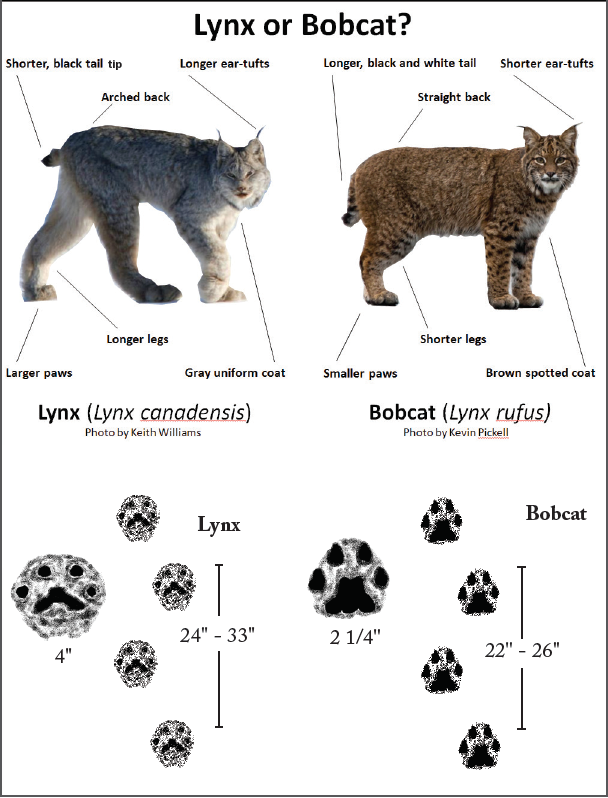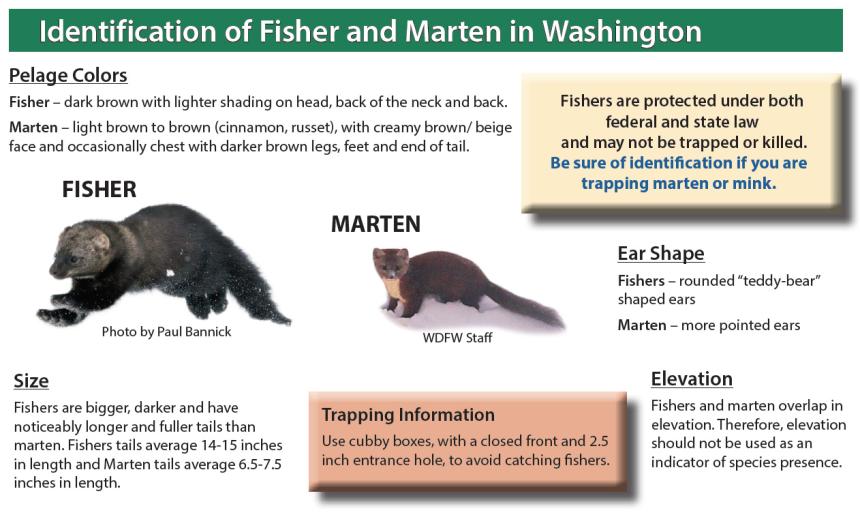These rules are effective from April 1, 2024 to March 31, 2025, both dates inclusive.
Download PDF version of the regulation pamphlet. (PDF)
Before trapping, please review the Guidance to Prevent Human Transmission of SARS-CoV-2 to Wildlife (PDF)
Trapper Education and participation requirement
People buying a Washington State Trapping License for the first time must pass an exam in safe, humane, and proper trapping techniques. For information on trapper education see the Hunter Education website or contact the Hunter Education section of the Washington Department of Fish and Wildlife (WDFW) office in Olympia at 360-902-8111.
***A valid Washington state trapper's license is required per WAC 220-417-010.
Annual license fees
A trapping license year begins on April 1 and ends on March 31 of the next year. Fees below include transaction and dealer fees.
- Resident Trapping License $41.60
- Resident Youth Trapping License $18.50
- Non-Resident Trapping License $200.00
- Fur Dealer’s License $200.00
Trapping and fur dealer's licenses are available online at fishhunt.dfw.wa.gov and at all WDFW license dealers. Trapping and fur dealer’s licenses may also be purchased through the Commercial Licensing program at the WDFW Olympia headquarters office (in person or by mail) for an additional application fee.
Statewide trapping seasons
| Furbearer species | Seasons dates | Restrictions |
|---|---|---|
| Badger, Beaver, Bobcat, Mink, Muskrat, Raccoon, River otter and Weasel | Nov. 1 - Mar. 31 during the current license year | |
| Marten | Nov. 1 - Mar. 31 during the current license year | CLOSED in Clallam, Jefferson, Mason, and Grays Harbor counties |
| Red fox | Nov. 1 - Mar. 31 during the current license year | CLOSED in the exterior boundaries of the Mount Baker-Snoqualmie, Okanogan, Wenatchee, and Gifford Pinchot national forests |
The trapping season authorizes the lethal harvest of furbearing animals for their hides and pelts only. Furbearers may not be taken from the wild and held alive for sale or personal use without a special permit pursuant to WAC 220-450-030. Any wildlife trapped for which the season is not open shall be released unharmed. Any wildlife that cannot be released unharmed must be left in the trap, and a WDFW representative must be notified immediately. Lawfully trapped wild animals must be lethally dispatched or immediately released. A firearm may be used to dispatch trapped animals where firearm use is allowed. For more information on lethal dispatch, see the Trapping Nuisance Wildlife website and the Trapper Education manual.
Trap check requirements
- Restraining traps (any non-killing set) must be visually checked (via binoculars, trail camera, spotting scope, or in person) each calendar day and captured animals must be removed within 24 hours of capture.
- Kill traps must be checked and animals removed within 72 hours.
Sealing requirements for bobcat and river otter
It is unlawful to possess or export from the state of Washington bobcat or river otter pelts taken in Washington without a department identification seal attached. All bobcat and river otter pelts, on or off the carcass, must be presented by the person harvesting them to an authorized department employee or authorized individual under permit with the department for sealing by April 20. Pelts must be presented in a way that the hide can be sealed. No frozen hides or carcasses will be accepted. Pelts must be fully thawed prior to sealing appointment if previously frozen. Contact a regional office to schedule an appointment for pelt sealing prior to bringing in a bobcat or river otter.
NEW in 2024: bobcat lower jaw submission requirements
Hunters or trappers harvesting a bobcat must also provide a cleaned and dried complete lower jaw (both sides) for aging before a pelt can be sealed. Before bringing in the lower jaw, remove as much flesh as possible and allow it to dry in the open air in a safe place, in a cardboard box or paper bag, or in a plastic bag with salt or borax to prevent decay. It is imperative to label the pelt and jaw so it is clear which pelt belongs to which jaw. Find more information about bobcat jaw submission requirements on our Bobcat webpage.
It is unlawful to trap for wild animals:
- With body-gripping traps EXCEPT by permit to abate an animal problem under WAC 220-417-040. These include, but are not limited to, padded foot-hold traps, unpadded foot-hold traps, all snares, and conibear-type traps.
- Using game birds, game fish, or game animals for bait, except nonedible parts of game birds, game fish, or game animals may be used as bait.
- Within thirty feet of any exposed meat bait or nonedible game parts which are visible to flying raptors.
Identification of traps and disclosure of identities
Trappers shall attach to the chain of their traps or devices a legible metal tag with either their WDFW identification number (trapper ID or Wild ID) or the name and address of the trapper in English letters not less than one-eighth inch in height. Failure to identify traps is a misdemeanor punishable under RCW 77.15.190. When a property owner, lessee, or tenant presents a trapper identification number to WDFW and requests the identification of the trapper, WDFW shall provide the requestor with the name and address of the trapper. After disclosing the trapper’s name, WDFW will also release the requesting individual’s name and address to the trapper. It is unlawful to take a wild animal from another person’s trap without permission, or to spring, pull up, damage, possess or destroy the trap; however, it is not unlawful for a person to remove a trap placed on property owned, leased, or rented by the person. See RCW 77.32.545.
Permission to trap on private land
A state trapping license allows the holder to trap furbearing animals throughout the state; however, a trapper may not place traps on private property without permission of the owner, lessee, or tenant where the land is improved and apparently used, or where the land is fenced or enclosed in a manner designed to exclude intruders or to indicate a property boundary line, or where notice is given by posting in a conspicuous manner.
Closed areas
Most public lands are open to trapping, but some areas may be closed. Closed areas include, but are not limited to, state and national parks, most federal wildlife refuges, and state game reserves. Trappers should check with land managers prior to trapping. Legal descriptions of state game reserves are found in the Migratory Waterfowl and Upland Game Pamphlet and Chapter 220-411 of the Washington Administrative Code.
Trapper report of catch
All licensed trappers must report their trapping activity (regardless of success or whether they trapped or not) by April 20. Annual reports must be made using the department’s WILD licensing system, found online at fishhunt.dfw.wa.gov. It is the responsibility of the licensed trapper to ensure their report is complete, with all trapping activity and harvest reported. Any trapper not reporting by April 20 will be in noncompliance of reporting requirements. False reports will be considered the same as noncompliance. Failure to report trapping activity is an infraction, punishable under RCW 77.15.160.
Incidental take of fox
The Cascade red fox is a state-endangered subspecies of fox that are protected in Washington. Fox trapping is closed within the exterior boundaries of the Mount Baker-Snoqualmie, Okanogan, Wenatchee, and Gifford Pinchot National Forests to protect this subspecies. Any uninjured fox that is accidentally trapped in areas closed to fox trapping must be released immediately and the incident must be reported to WDFW (WildThing@dfw.wa.gov or 360-902-2515) within 24 hours. The report must include the circumstances surrounding the incident, observed physical and ambulatory condition of the fox, and final disposition of the fox. Any fox that cannot be released unharmed must be left in the trap, and a WDFW representative must be notified immediately.
Incidental take of Canada lynx, fisher, and wolverine
Canada lynx, fisher, and wolverine are protected in Washington. Accidentally trapped Canada lynx, fisher, or wolverine that are uninjured must be released immediately and the incident must be reported to WDFW (WildThing@dfw.wa.gov or 360-902-2515) within 24 hours. The report must include the circumstances surrounding the incident, observed physical and ambulatory condition of the animal, and final disposition of the animal. Any Canada lynx, fisher, or wolverine that cannot be released unharmed must be left in the trap, and a WDFW representative must be notified immediately.


This pamphlet is a summary of the trapping seasons and regulations (Chapters 220-400, 220-417, 220-440 and 220-450 of the Washington Administrative Code) adopted by the Washington Fish and Wildlife Commission. This pamphlet does not contain nor is it intended to contain all department regulations. Caution: Emergency regulation changes may occur while seasons described in this pamphlet are in effect and will supersede information contained herein. Area news media will be informed of changes as they occur.
